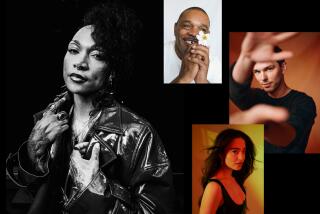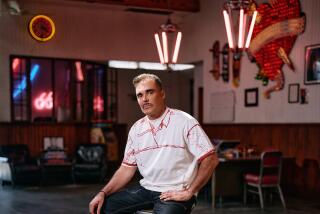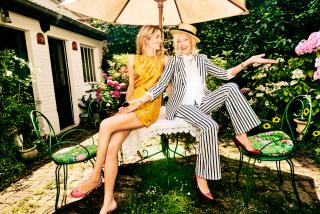A Window on the World
- Share via
Ask French photographer Marc Riboud a simple question and you get a simple answer.
“How did you get started in photography?”
“By taking a picture.”
He isn’t kidding, and he isn’t being flippant. Riboud’s distinguished career began around 1930, when he was a 7-year-old kid, innocently riding his bicycle on a country road near his childhood home in Lyons.
“A couple on a motorbike stopped, handed me their camera and asked me to take a picture of them,” Riboud said, reached by telephone at his studio in Paris. “They started embracing and kissing. I was shaking, but I did it, gave the camera back to them and left. I never saw my first picture.”
Millions of people have seen his photographs since then. Shot in France, England, Switzerland, Iran, India, Nepal, China, Vietnam and Africa, his widely published pictures include such memorable images as “Eiffel Tower Painter” (1953), depicting a man who appears to be doing a dance while painting at a terrifying height, and “Peking” (1965), a Chinese street scene framed by windows of a train.
Riboud also has compiled a lengthy, international exhibition record. Capping the list, a 40-year retrospective of his photographs of China, organized by the National Center of Photography in Paris, traveled to Beijing last fall and will appear at the International Center of Photography in New York this summer.
And now Los Angeles is on Riboud’s itinerary. He is scheduled to arrive here this week for a survey of his work, opening Tuesday at the Stephen Cohen Gallery on Beverly Boulevard. Riboud will give a lecture Wednesday night at the Los Angeles County Museum of Art.
His visit is timed to coincide with Photo L.A., the sixth annual photography fair organized by Cohen, to be held Friday through next Sunday at Butterfield & Butterfield in Hollywood. Riboud is billed as guest of honor for the event, which will assemble about 40 photography dealers from across the country under one roof.
*
While the work of hundreds of artists is on view at the fair, Cohen’s gallery will present a mini-retrospective of Riboud’s career. Essentially introducing the French photographer to L.A., the show will offer an overview--including classic images, pictures of Paris made in the 1950s and a sampling from his Asian journeys.
Visitors to the gallery will see that Riboud has come a long way from his childhood encounter with a camera. But at 73, he hasn’t lost his fascination with photography. “When people ask me what my favorite photograph is, I say it’s the one I’m going to shoot tomorrow or next week,” Riboud said. “Photography is looking to the front, not behind.”
But he doesn’t mind chatting about the past. Musing about that first picture of the kissing couple, he said the experience left him with the feeling of having done something thrillingly surreptitious but vaguely wrong. He had intruded into strangers’ lives and recorded an intimate moment. But, as it turned out, he was hooked.
His next encounter with photography came in 1937, when his father gave him a vest pocket Kodak he had used during his tour of duty in World War I. “I was the fifth of seven children. I don’t know why he gave the camera to me, but I thought it was an omen,” Riboud said.
After the death of his father, in 1939, Riboud acquired yet another camera. This one--a Leica--was loaded with family history that could be interpreted as destiny. “My father was a banker, very brilliant and intelligent,” he said. “After earning his degree in public school in France, he spent a year at Oxford. To congratulate him for his good performance there, his father--my grandfather--gave him the camera and a trip around the world in 1910. He traveled for two years with a friend and kept a diary of his experiences.”
As a young teenager, Riboud had been enchanted with the diary. He read it over and over, learning favorite parts by heart. Indeed, the diary may have had something to do with his wanderlust, but other factors were more important, he said. The first was World War II: Riboud worked in the Resistance in Lyons and served in the French army from 1943 to 1945, but the war prevented casual travel, even from his home in Lyons to Paris. “There was pent-up impatience to travel after the war,” he said.
*
Riboud was educated as an engineer and worked in a factory in Lyons after the war. Despite his interest in photography, he was advised to keep his job by no less than Henri Cartier-Bresson, the influential French photographer who rose to prominence in the 1940s. But Riboud ignored the advice. “I was a bad engineer,” he said. “I was bored. In 1951, I took a week’s leave to photograph a music festival in Lyons. I never returned. They are still waiting for me.”
Taking his first photographs in Paris in 1952, he renewed his acquaintance with Cartier-Bresson and met photojournalists Robert Capa and David Seymour, who were among the founders of the Magnum picture agency. Riboud joined Magnum in 1953, affiliating with a group largely known for recording topical events for the mass media. He stayed with the agency until 1979, but photojournalism isn’t a label that suits him.
“People like to classify,” he said. “For me, with photographs, there are only good ones and less good ones. I am only interested in quality, whether it’s abstract, documentary or a portrait.”
Riboud had clearly changed his profession from engineering to photography when he arrived in Paris, but opportunities seemed limited. “Most photographers there were shooting movie stars and famous people,” he said. “I was very shy. What could I do?”
The answer was to travel extensively. He photographed in India, Nepal and China in 1955-57 and returned to the Far East in 1958. The following year, he drove from Alaska to Mexico, photographing along the way. In 1960, he took his first trip to the Soviet Union; the next two decades took him to dozens of locations in Europe, Africa and Asia.
Probably best known for his work in China, beginning in 1956, he has compiled a remarkable record of that country’s transformation from a peasant society to a world power that seems to have sacrificed its culture to commerce. “My time in Asia was the best and the worst,” he said. “I was happy to discover the world there. The thing that makes me most unhappy is that Asia is all money, corruption and prostitution now.”
While working in China over the years, he had to tread a thin line between honest reporting and exposing things the Chinese did not want outsiders to see. That has changed to some degree, but he encountered a threat of censorship encountered a threat of censorship last fall when his 40-year retrospective was in Beijing. Government officials objected to street scenes containing images of beggars, young women who appear to be prostitutes and Chinese magazines with clothed pinup girls on the covers.
“For me, taking a few pictures out of more than 100 was not too important. It was the principle,” he said. “I knew people who had seen the show in Paris would notice, and that’s what would be written about. Also, independent Chinese photographers implored me not to give in because that would make things more difficult for them.” Riboud insisted on keeping the show intact and the censors dropped their demands.
In general, though, confrontation is not his style. Introverted and silent as a child, he was intimidated by his older, more outgoing siblings, so he developed a private life of visualpleasure. Photography offered him a way to develop that sensitivity, but also to overcome inhibitions, he said. “When you are shy, the camera is a shield. It allows you to get close without talking to people. But the camera also gives you tremendous energy to get closer.”
He has no patience with people who speak of photography as a creative venture. “We aren’t creators, we’re interpreters,” he said. But interpreting the world around him is enormously satisfying: “What fantastic luck we have as photographers, to record what we like in life.”
*
* “Marc Riboud,” photographs, Stephen Cohen Gallery, 7358 Beverly Blvd. Opens Tuesday. Tuesdays through Saturdays, 11 a.m. to 5 p.m. Ends Feb. 22. (213) 937-5525.
Riboud will lecture on his work at the Los Angeles County Museum of Art, Dorothy Collins Brown Auditorium, 5905 Wilshire Blvd., on Wednesday at 7 p.m. Free. Reservations: (213) 857-6071.
More to Read
The biggest entertainment stories
Get our big stories about Hollywood, film, television, music, arts, culture and more right in your inbox as soon as they publish.
You may occasionally receive promotional content from the Los Angeles Times.










